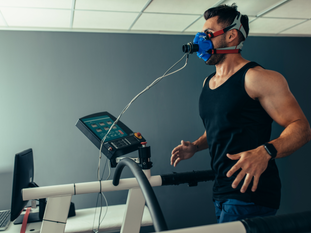
Unlocking the Secrets of VO2 Max: Your Guide to Enhanced Health and Longevity
Dec 1, 2024
3 min read

When it comes to understanding your fitness and overall health, few metrics are as insightful as the VO2 Max. Often tossed around in fitness circles and professional sports, VO2 Max might sound complex but its implications are straightforward and far-reaching. Simply put, VO2 Max measures the maximum volume of oxygen your body can use during intense exercise. It’s expressed in milliliters of oxygen used in one minute per kilogram of body weight (ml/kg/min) and is a telling indicator of your cardiovascular fitness.
Understanding VO2 Max in Simple Terms
Imagine your body as an engine and oxygen as the fuel it burns for energy. VO2 Max is essentially the measure of the largest amount of fuel (oxygen) your engine (body) can convert to energy in a minute during peak exercise intensity. The higher your VO2 Max, the more oxygen your body can use, and the more energy it can produce. This capability directly translates to better endurance and athletic performance, particularly in activities like running, cycling, and swimming.
The Importance of VO2 Max to Your Health
But why should you care about VO2 Max if you’re not planning to run a marathon or climb a mountain anytime soon? Because it’s not just about athletic prowess; it’s a fundamental measure of your cardiovascular health. A higher VO2 Max indicates a heart that can pump more blood, lungs that have a better capacity, and muscles that are more efficient at consuming oxygen. All these factors help in everyday activities and in reducing the load on your heart, thereby enhancing your overall health.
VO2 Max and Longevity: What Does the Research Say?
Research has consistently shown that individuals with higher VO2 Max levels have a lower risk of death from all causes, including heart disease and cancer. A landmark study published in the Journal of the American College of Cardiology found that increasing VO2 Max levels are associated with substantial reductions in the risk of premature death. This is likely due to the role of VO2 Max in improving heart health, metabolic function, and even mental health through better blood flow and higher levels of fitness.
How to Train to Improve Your VO2 Max
Improving your VO2 Max might sound daunting, but it’s quite achievable with the right approach. Interval training, where you alternate short bursts of high-intensity exercise with longer periods of recovery, is one of the most effective methods. For example, you could try a running workout that consists of warming up for 10 minutes, running at a near-maximal effort for 2-3 minutes, then walking or jogging for 3-4 minutes to recover, and repeating this cycle 4-5 times.
Cycling, swimming, and rowing are also excellent for VO2 Max workouts because they engage major muscle groups and can be sustained for the necessary durations. The key is to push into the high-intensity zone where speaking in full sentences would be challenging. Consistently training at these levels will gradually increase your VO2 Max as your heart and muscles adapt to the demands.
However, it’s important to build up these sessions gradually to prevent injury, especially if you are new to high-intensity workouts. Incorporating strength training, adequate rest, and proper nutrition will also support improvements in VO2 Max and overall fitness.
Final Thoughts
Understanding and improving your VO2 Max is a powerful way to not only boost your physical performance but also enhance your health and extend your life. Whether you’re a competitive athlete or someone interested in general fitness, measuring and working to increase your VO2 Max can provide valuable insights into your cardiovascular health and physical capabilities. Like any fitness goal, it requires dedication and consistency, but the benefits to your longevity and well-being are well worth the effort.






